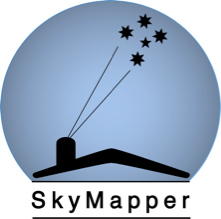feedersurveys
Feeder Surveys
PESSTO survey relies on partnered ‘feeder’ surveys to discover fresh supernova candidates that we can then confirm, classify and follow in detail if we deem the objects as peculiar or interesting. The feeder surveys include La Silla-Quest, Pan-STARRS1, CHASE and eventually SkyMapper when it begins full survey operations.
La Silla-Quest.

The La Silla-QUEST Variability survey is a project utilising the 40” ESO Schmidt Telescope at the La Silla Observatory of the European Southern Observatory in Chile. Onboard the telescope is the new large area QUEST camera, a mosaic of 112 CCD’s covering the full field of view of the telescope (approximately 40 x 40 ), built at Yale University and Indiana University. The camera is installed at the prime focus of the ESO Schmidt Telescope and commissioned in early 2009.
-
The main supernova survey runs from September through May, operating with 2 or 3 day cadence with two 60 sec exposures each night to eliminate asteroids and other stuff.
-
The telescope is regularly surveying 1000 square deg per night down to a depth of 20th in full moon, 21st in new moon.
-
ESO have granted La Silla-Quest full time access to the telescope until Sept 2014, but this can be extended if there is a good reason.
Pan-STARRS1.

PS1 is the first Panoramic Survey Telescope & Rapid Response System (Pan-STARRS) telescope, located at the summit of Haleakala on Maui, Hawaii. It began full time science observations on May 13, 2010.
PS1 repeatedly observes the whole sky accessible from Hawaii. The combination of a medium-size (1.8m), fast telescope, with the largest digital camera built to date (1.4Gpixel), and an efficient computer network to quickly process the data, constitutes a powerful observatory.
The PS1 3Pi search is making progress with transients and vast numbers of asteroids being discovered regularly. The data is certainly good enough for a wide-field, local Universe search (similar mag limits to LaSILLA/QUEST and SkyMapper).
-
The 3Pi survey goes down to -30° declination. Hence 2Pi of the sky (or 2/3 of PS1 survey) is within the +30° to -30° declination range of the NTT.
-
3Pi revisits the same patch of sky 6 times in lunation, with a typical cadence of 5 days, down to a depth of ~21.5mags.
-
The PS1 survey is guarantied only to Oct. 2012 but negotiations are underway for extension of 1yr, plus plans for a PS1+PS2 survey longer term.
For more information, please see the Pan-STARRS1 webpages.
CHASE.

Launched in March 2007, Chilean Automatic Supernova Search (CHASE) project operates with the scientific goal of studying the origin of the accelerating universe from supernovae distances measured in nearby galaxies.
CHASE repeatedly surveys a sample of 10,000 galaxies with 4 x 0.4m Panchromatic Robotic Optical Monitoring and Polarimetry Telescopes (PROMPT), revisiting galaxies every four nights. Image subtraction is used to identify transients.
For more information, please see the CHASE webpages.
SkyMapper.

SkyMapper is sited under the dark skies of Siding Spring Observatory near Coonabarabran, central NSW. SkyMapper’s mission is to robotically create the first comprehensive digital survey of the entire southern sky.
Onboard the 1.35m telescope is a unique 268Mpix digital camera designed and constructed in house by ANU technicians. The camera captures a region of sky 29 times larger than the full moon every minute.
-
The SkyMapper survey will run all year with an average cadence of 3-4 days.
-
Long-term SkyMapper operations will be divided into “main survey” and “bad seeing” components, with seeing conditions worse than about 1.8” (25% of the telescope time) being devoted to a rolling search for supernovae.
-
The survey will be dynamically scheduled each night by software, and will be able to adapt to changing seeing conditions over the course of a single night (i.e., scheduling partial nights for the SN search).
-
SkyMapper will reach a depth of
~20mag(signal-to-noise = 5) in SDSSgriand a Stromgren-likevfilters. -
SkyMapper will run for five years (main survey + SN search).
For more information, please see the SkyMapper webpages.
